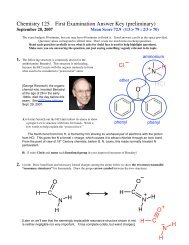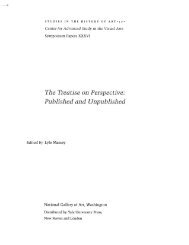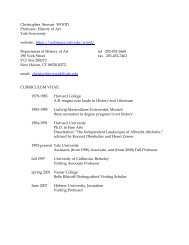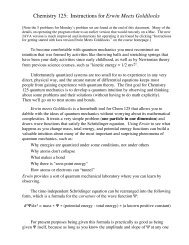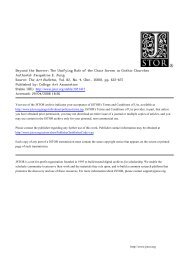Sample Quantum Mechanics Questions
Sample Quantum Mechanics Questions
Sample Quantum Mechanics Questions
You also want an ePaper? Increase the reach of your titles
YUMPU automatically turns print PDFs into web optimized ePapers that Google loves.
8. The curve below is Psi, a solution to the Schrödinger equation for a familiar typeof potential energy function. The horizontal line is at a Psi value of 0. Thefunction continues to the right as a sine wave.A. (8 minutes) Complete the lower graph by adding a potential energy functionthat would give this Psi for the total energy shown. In a few words explainhow key features of the energy plot are reflected in features of Psi.EnergyTotal EnergyB. (1.5 minute) Name the potential function and say what chemical phenomenon it couldrepresent.C. (3 minutes) Could other acceptable Psi functions be found with any old nearbyenergy? Explain.
9. Below are shown three potential energy functions (as dashed lines) and threesuperimposed wave functions (as solid lines) that are solutions of the corresponding onedimensionalSchrödinger equations (mass = 1 in each case). Each half of the two doubleminimum potentials is identical to a corresponding portion of the single minimumpotential (which is for a single bond "harmonic oscillator"). Obviously there is a cruderesemblance in shape between a portion of the first wave function and the left half ofeach of the others.A. (3 minutes) On each potential energy diagram draw a horizontal line denoting theactual total energy. Explain in a few words, and by drawing on the diagrams, howyou decided where to position each line.
C:D:E:8. (3 min) Is the energy of this wave function in Question 7 quantized? That is, would a very slightlyaltered energy also yield a satisfactory wave function? Explain your thinking.9. (3 min) The wave function below is a solution to the Schödinger equation for exactly the samepotential energy curve as the one in Question 7, and it has exactly the same total energy. Whatmust have changed? Explain.10. (1 min) Don't waste time on this unless you havecompleted the rest of the rest of the exam.The small figure at the right is an overlay of thewave function of Question 7 with that ofQuestion 9. Explain why the latter does notextend as far to right or left as the former andwhat this teaches about tunnelling.
Thomson in Wonderland5a. (3 min) Most people nowadays make fun of J. J. Thomson's "Plum Pudding" atom, but he proposed itfor a good reason. Describe the model, and explain the relevance of Earnshaw's Theorem.5b. (2 min) After Rutherford demonstrated that the nucleus was tiny, how did Thomson suggestaccommodating Earnshaw's Theorem (in 1923)?The diagrams show the Coulombic potential for a one-dimensional Hydrogen atom as a dashed curve, and,as solid curve "A", a wave function that solves Schrödinger's equation for the mass of an electron. Thehorizontal axis is the distance of the electron from the proton. The dashed horizontal line is the total energyfor this wave function. The second diagram includes an unsatisfactory trial wavefunction, "B", which isplotted for the SAME ENERGY, but TWICE the MASS.5c. (4 min) Use the quantum mechanical formula for kinetic energy to explain the way in which "B"differs from "A".
c) (2 min) What is fundamentally wrong with a wavefunction of this type?d) (5 min) Use this example to describe how one goes about modifying a wave function by the Self-Consistent-Field procedure without introducing any additional terms into the formula.



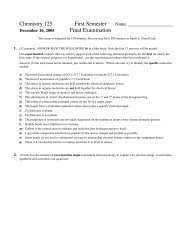
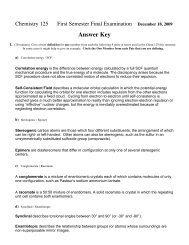
![Review: [untitled] Author(s): Christopher S. Wood ... - Yale University](https://img.yumpu.com/47633680/1/184x260/review-untitled-authors-christopher-s-wood-yale-university.jpg?quality=85)

